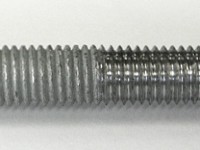Can threads be chased after hot-dip galvanizing for proper nut fit?

Absolutely not! Externally threaded fasteners should never be “chased”. During the hot-dip galvanizing process, excess zinc has a tendency to build up in the threaded portion of a fastener. Chasing threads is a term used to describe re-cutting threads after galvanizing to remove this excess zinc that has accumulated during the galvanizing process. Chasing threads will not only remove the excess zinc but often removes much, if not all of the zinc coating and eliminates the corrosion protection on the threaded portion of the fastener. Chasing, if not performed with extreme precision, can also remove additional steel from the threaded portion of the fastener resulting in threads that are undersized and out of tolerance.
One misconception with regard to galvanized threads is that the threads are cut undersized to accommodate the extra 2-6 mils of zinc thickness that hot-dip galvanizing adds. Actually, bolts are threaded the same regardless of whether or not they will be galvanized. It is the galvanized nuts that are tapped oversize to ensure a proper fit. When galvanized bolts are chased and some or all of the zinc is removed from the threaded area, the galvanized nuts which are tapped oversize will be too loose and not generate the proper clamping force required of the connection. The tolerance for tapping galvanized nuts is covered under A563.
ASTM F2329, the specification that covers hot-dip galvanizing of fasteners, clearly prohibits chasing threads after galvanizing stating, “Fasteners that have been hot-dip galvanized shall not be further altered (such as subjected to a cutting, rolling, finishing-tool operation) by the galvanizer unless specifically authorized in writing…”
Portland Bolt’s custom galvanizing system is specifically designed for threaded fasteners and uses centrifugal force to clean the threads. After parts are removed from the molten zinc they are immediately spun using a high-speed centrifuge to remove the excess zinc. This process creates high-quality galvanized threads and a trouble-free nut fit. Although some galvanizing companies do a good job of processing fasteners, the reality is that many other galvanizing companies simply do not have the specialized equipment and systems to properly galvanize fasteners. For galvanizing companies, fasteners are a hassle. Galvanizers charge their customers a price per pound and profitability for them is driven by the amount of weight they can put through their system per hour. Galvanizing companies prefer to galvanize large structures like beams, plates, and poles that are heavy, in and out of the tank quickly and don’t require the high degree of quality control that threaded fasteners require. For this reason, many fastener manufacturers will be forced to “chase” the threads of fasteners after they have been hot-dip galvanized.
Ensure you are receiving galvanized bolts in which the threads have not been chased by questioning your supplier as to the methods used to clean the threads. Any form or re-cutting of the threads after they have been galvanized is simply unacceptable.


“Absolutely not! Externally threaded fasteners should never be “chased”. ”
Thank you sir! Just what I thought!
Hi
You can make a vibrator to remove extra zink deposit
@Chhabra- yes, a mechanical deburring machine can be used to smooth out any rough edges left by galvanizing.
Dear sir
I am facing same problem. Is it possible to eliminate excess zinc from threaded portion by heating the threaded portion and brushing it.
@Ajeet- Yes, that method is acceptable, as long as the bolt is not a heat treated item. If so, care should be used when heating.
Why not as long as you don’t use flame. Induction heat would be best
Hello,
How fast centrifuge go? In the recent past most galvanizers have reduced the speed and lowered the temperature of the Zinc solution which is of course disastrous about 10% of the time on most diameter fasteners but a lot more on say, M12 or 1/2 inch fasteners. Voigt and Schweitzer were great until they just went away….
Thank you
@Paul- Centrifuge speeds will vary by manufacturer. I cannot disclose the specifics of our operation, but I can tell you that we can galvanize 1/2″ and larger fasteners without any trouble.
Thanks Dane for your prompt reply.
I was looking for those different methods of HDG long threaded rods. I did try to find the solution but all efforts in vein.
Makarand,
Were you able to find a solution to cleaning threads on your rods? We are currently in a similar situation and have not been able to find any good info on how to clean the threads on our structural cross rods that were dipped and now have many of the threads completely filled with zinc. So far chasing the threads seems to be my only option.
Any help on this is welcome.
@Gustofson- The threads on galvanized fasteners are typically cleaned by the galvanizer while the metal is still hot. Once it cools it can get a bit more tricky. Both A153 and F2329 specifically prohibit the chasing of threads after galvanizing, although I can see your dilemma. We don’t have any recommendations on how to fix that, short of making sure your rods are sourced from someone who understands galvanized threads.
Excellent information on HDG of Bolts.
For 8 – 10 meter long rods with threads at either side for HDG, these type of rods are very difficult to centrifuge. What do you recommend in such cases.
@Makarand – You are correct that rods that long may be too long to centrifuge. There are other methods for removing excess zinc from threads, but the method may vary from galvanizer to galvanizer depending on their equipment and their customers’ needs.
You say: “One misconception with regard to galvanized threads is that the threads are cut undersized to accommodate for the extra 2-6 mils of thickness that hot-dip galvanizing adds.”
Well, just to clarify, surely this is not a misconception. ISO 10684 standard, Fasteners – Hot dip galvanized coatings state both methods.
1. The threads are undersized (tolerance 6az) before galvanizing. After galvanizing they accept normal sized nut (tolerance positions G And H).
2. The threads are made to normal size (6g) before galvanizing. After galvanizing oversized nuts (6AZ) must be used.
In many European countries the method of making the bolt thread undersized (6az) before galvanizing is generally used.